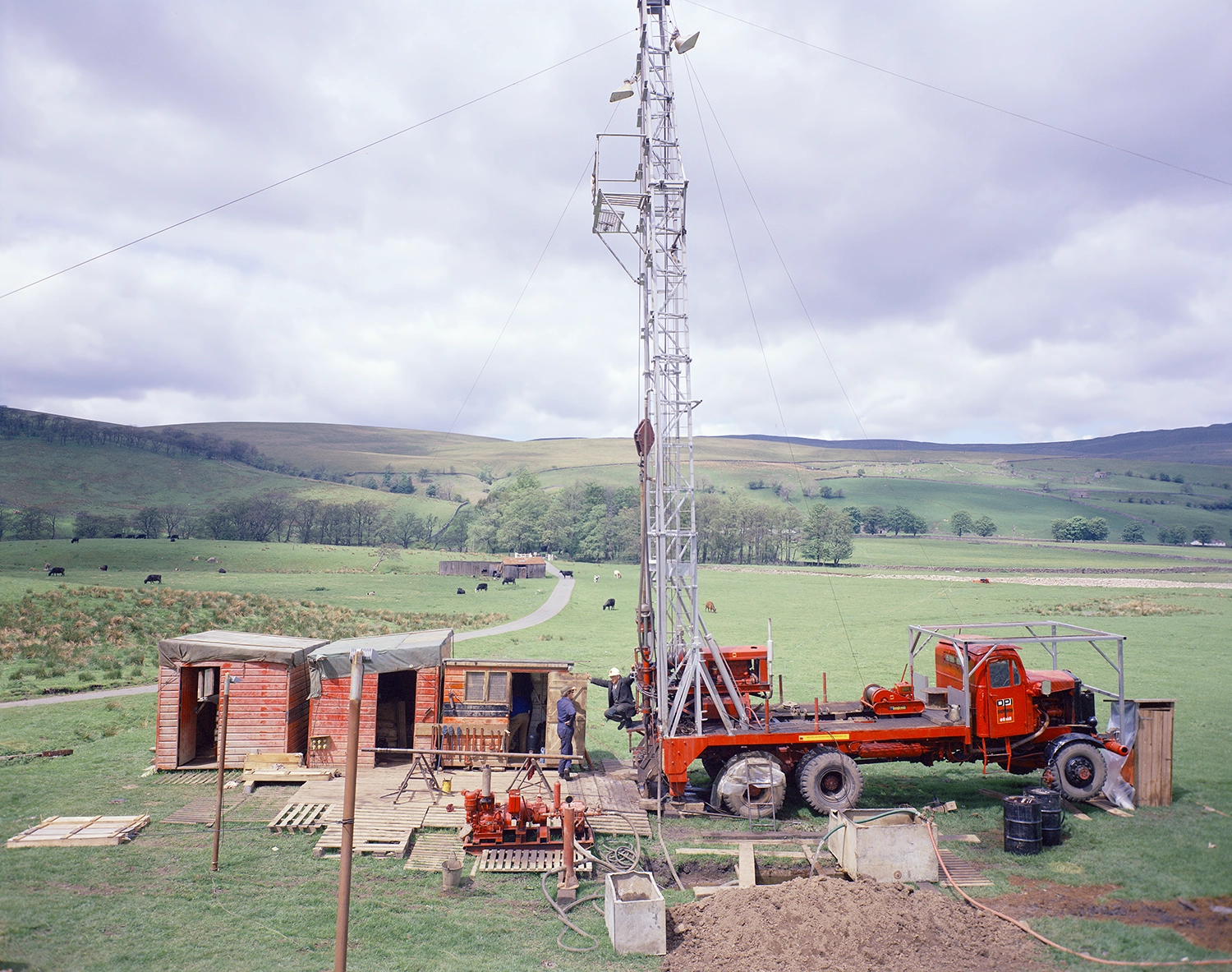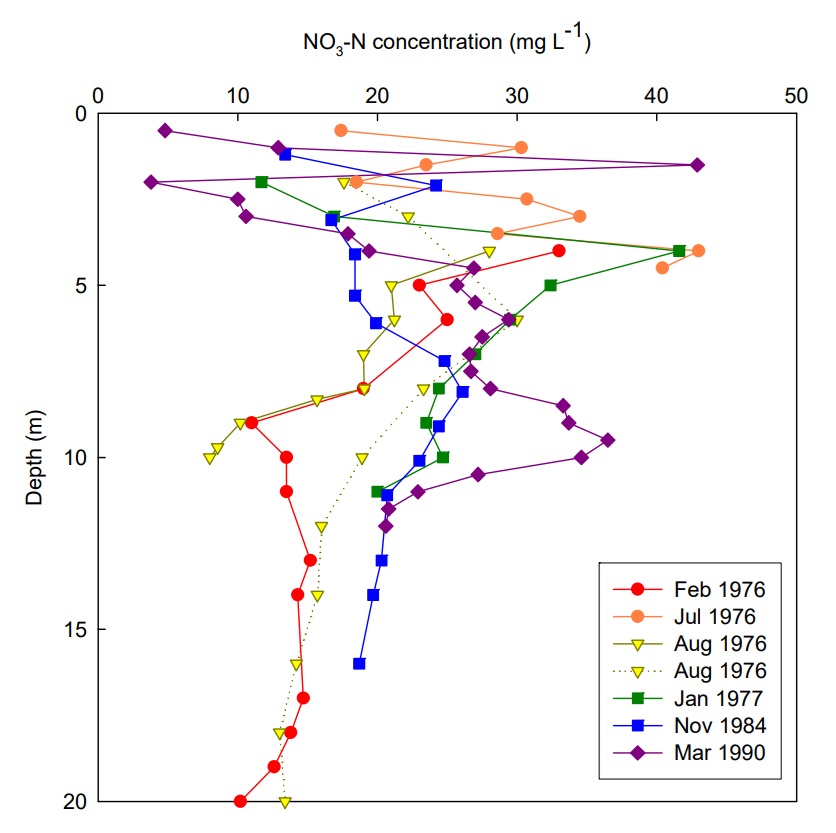Nitrate contamination of groundwater has long been recognised as an important public health issue. The majority of nitrate in groundwater in the UK is derived from diffuse pollution from agriculture, with the rest from sewage sludge disposal on land, atmospheric deposition and point sources. The loading has significantly increased due to post-1945 agricultural intensification, due both to ploughing of grassland and increased fertiliser application.

Borehole drilling in Raydale in the Yorkshire Dales, 1973. BGS used cored boreholes to obtain profiles of the unsaturated zone pore-water nitrate concentration as a function of depth in work pioneered in the 1970s. BGS © UKRI.
Nitrate in the unsaturated zone
Pioneering work was done in the 1970s to understand how different UK land-use practices affected nitrate leaching to groundwater and how nitrate moves through the unsaturated zone of major aquifers. BGS used cored boreholes to obtain profiles of the unsaturated zone pore-water nitrate concentration as a function of depth.
Sequential profiles can be used to estimate unsaturated zone travel time. BGS holds a nitrate profiles database containing over 350 nitrate profiles.
This research showed that downward movement of nitrate stored in the aquifer matrix to the water table was only about 0.7 to 2 m per year for the major aquifers of the Chalk and Permo-Triassic sandstone.

Sequential nitrate profiles from Site NN1, Bircham, Norfolk, England, from 1976 to 1990. From Stuart, 2005. BGS © UKRI.
Where the unsaturated zone is thick, this stored nitrate will continue to arrive at the water table for many years to come: we call this the nitrate time bomb. BGS has also quantified the amount of nitrate stored in the unsaturated zone globally for the first time.
This delay has implications for groundwater management and meeting the requirements of the Water Framework Directive.
Rising nitrate concentrations in groundwater
Groundwater nitrate concentrations in some locations are now high and are often approaching, or have already exceeded, statutory limits for drinking water. They are rising at an average 0.3 mg/L/year and many sites show seasonal variation, with highest concentrations during the winter and spring corresponding to high water levels. It is likely that climate change is affecting nitrate leaching to groundwater.
- Trends in nitrate concentrations in UK groundwater
- Nitrate fluctuations in groundwater
- Predicting the arrival of peak nitrate concentrations at the water table
- Climate change effects on nitrate concentrations in groundwater
Further reading
Ascott, M, Lewis, M, Gooddy, D, Mackay, J, Smedley, P L, and Cartwright, C. 2022. Impacts of climate and land use change on groundwater quality in England: a scoping study. British Geological Survey Open Report OR/22/076. (Nottingham, UK: British Geological Survey.)
Ascott, M J, Gooddy, D C, Marchant, B, Kieboom, N, Bray, H, and Gomes, S. 2024. Regional scale evaluation of nitrate fluctuations in groundwater using cluster analysis and standardised hydrometeorological indices. Journal of Hydrology, Vol. 634, 131052. DOI: https://doi.org/10.1016/j.jhydrol.2024.131052
Bell, V A, Naden, P S, Tipping, E, Davies, H N, Carnell, E, Davies, J A C, Dore, A J, Dragosits, U, Lapworth, D J, Muhammed, S E, Quinton, J N, Stuart, M, Tomlinson, S, Wang, L, Whitmore, A P, and Wu, L. 2021. Long term simulations of macronutrients (C, N and P) in UK freshwaters. Science of The Total Environment, Vol. 776, 145813. DOI: https://doi.org/10.1016/j.scitotenv.2021.145813
Chilton, P J, and Foster, S S D. 1991. Control of groundwater nitrate contamination pollution in Britain by land-use change. 333–347 in Nitrate Contamination: Exposure, Consequence and Control. Bogárdi, I, Kuzelka, R D, and Ennenga, WG (editors). NATC ASI Series, Vol. G30. (New York, USA: Springer-Verlag.) DOI: https://doi.org/10.1007/978-3-642-76040-2_25
Foster, S S D, and Crease, R I. 1974. Nitrate pollution of Chalk groundwater in East Yorkshire — a hydrogeological appraisal. Journal of the Institute of Water Engineers, Vol. 28, 178–194.
Foster, S S D, and Young, C P. 1980. Groundwater contamination due to agricultural land-use practices in the United Kingdom. 262–282 in Aquifer Contamination & Protection, UNESCO-IHP Studies and Reports in Hydrogeology Series, 30.

